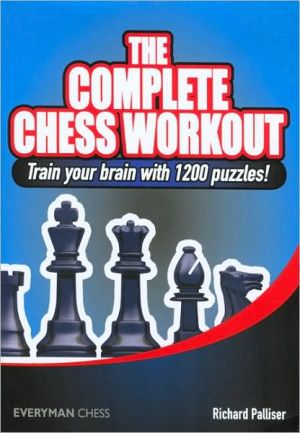

 |

|

The average rating for The Complete Chess Workout based on 2 reviews is 4 stars.
Review # 1 was written on 2015-04-01 00:00:00 Ryan Ragsdale Ryan RagsdaleThis is the best chess book I've ever read. I hate chess books that "annotate" games, and right from the beginning you are confronted with: 1. d4 d5 2. Nf3 Nc6 3. e3 Nf6 4. Bd3 e6 5. b3 Bd6 6. Bb2 O-O 7. O-O Re8 8. Ne5 Ne4 9. Nd2 f5 10. f3 Nxd2 11. Qxd2 Nxe5 12. dxe5 Bc5 13. Bd4 Bb6 14. f4 c5 15. Bb2 c4 16. Be2 Qc7 17. Rac1 Rd8 18. Bd4 Bxd4 19. Qxd4 c3 20. Rcd1 Bd7 21. a4 and the comment that follows is: "A4?!?! Haha what a fool, the game is lost! OBVIOUSLY." But THIS book has a comment after EVERY move for both white and black, explaining what they are thinking, what their plan is, what they are reacting to. It was so helpful and such a pleasure to read. I'd recommend it for anyone learning more about chess strategy. |
Review # 2 was written on 2015-05-02 00:00:00 Howard Myers Howard MyersBooks explaining chess, move by move have been popular ever since Irving Chernev and Max Euwe did the pioneering work. This book by Neil McDonald follows the trend set by these earlier works and begins with a beautiful preamble: When you sit down to play a game of chess you are in command of exactly the same eight pieces and eight pawns that Capablanca, Fischer and Kasparov have used to create masterpieces of grand strategy and tactical precision. Their pieces didn't have heightened powers nor more fertile soil on which to work their stratagems: just the same 64 squares, 32 white and 32 black. The conclusion is obvious: there is a dynamic potential concealed in your pieces that could be released if only you had the right skill and insight. In this book he shows how to develop that skill and insight through 30 games played during the period 1978-2003. The players include Karpov, Kasparov and Anand among others. While there is some sweeping generalization and a slightly condescending attitude to older schools of thought, the book does justice to its avowed theme. However, one cannot help feeling that the winner's point of view prevails in this book. The loser is systematically outplayed, the logic of the position turning against him. In real life this seldom happens. More often, games are complex, following an uncertain course, and it's the player who makes the last but one mistake who wins. Over the years this book has been superseded by others in the genre. The most notable of them are Understanding Chess Move by move (Gambit. 2001) by John Nunn and Modern Chess Move by move by Colin Crouch (EverymanChess.2009). The commentary in these other books is deep and subtle, doing greater justice to complexities of modern chess than McDonald's work. You may still prefer to read this book first for its ease and simplicity. |
CAN'T FIND WHAT YOU'RE LOOKING FOR? CLICK HERE!!!